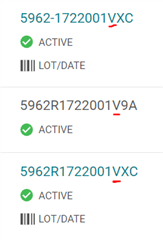Hi expert,
Does this package have a cavity structure?
My customer is considering whether need to do a PIND(PARTICLE IMPACT NOISE DETECTION) test.
Thanks.
This thread has been locked.
If you have a related question, please click the "Ask a related question" button in the top right corner. The newly created question will be automatically linked to this question.
Hi expert,
Does this package have a cavity structure?
My customer is considering whether need to do a PIND(PARTICLE IMPACT NOISE DETECTION) test.
Thanks.
Hi,
PIND test is included in the processing flow for TI's QML-V parts. The 5962 part number indicates whether a part is QML-V.
For this part, you can see the V's underlined in the image below indicate which part options are QML-V.

Here are some additional documents that may be useful for your customer:
.
Thanks,
Sarah
Hi Sarah,
Now, I know that all TI's QMLV products will do PIND test, but my customer is wondering if there is a report for PIND test.
They want to make sure Total Mass Loss (TML) is lower than 1.0%, Collected Volatile Condensable Material (CVCM) is lower than 0.10%.
Is these information could be found in QCI?
Hi Ryan,
I don't believe there is a published report for PIND test, but I am checking with our team and will let you know once I have an answer.
Thanks,
Sarah
Hi Ryan,
We do not publish a specific report showing details of the PIND test, but if the customer wants to understand how the test is performed then they can read the section on Method 2020 in this document.
If they are inquiring about TML and CVCM, then they are probably interested in Outgassing tests, not PIND. For our Space Enhanced Plastic (SEP) devices, we perform Outgassing testing as described by ASTM E595.
For our QMLV devices (like the TPS7H2201-SP), outgassing concerns are largely mitigated by using ceramic instead of plastic. Instead, Residual Gas Analysis (RGA) may be performed. That test is destructive so it is performed on samples and does not affect the units shipped to customers.
Thanks,
Sarah
Hi Sarah,
Thanks for your information. It's more and more clear to me now.
About PIND test, is there a method or flow for -SEP products? Just like QMLV flow.
Hi Ryan,
Glad this is useful. -SEP products have Production Flow and Reliability Reports displayed on their web pages in the Technical Documentation section.

These reports show the flow and qualification matrix for an -SEP device. PIND test only applies if there is an open cavity, which not all devices have.
Thanks,
Sarah